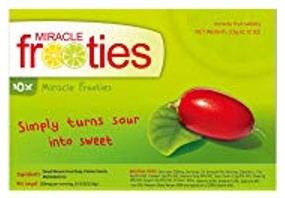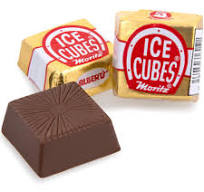
There are 10 Miracle Berry fruit tablets in one pack. Each tablet contains an extract of Miraculin (the active ingredient) from freshly harvested, organic Miracle Berries. All tablets are produced via non-GMO, 100% organic Miracle Berries. The active ingredient is a special glycoprotein called “miraculin” that creates this taste altering experience, which simply and effectively turns sour flavors, sweet. Transcend the concept of taste with these all-natural Miracle Berry fruit tablets.
As the Miracle Berry fruit tablets act to temporarily alter the taste buds and allow you to eat sour foods more easily, it can be used to aid in the regulation of a healthier diet by limiting your sugar intake. Try swapping out candy for a Miracle Berry fruit tablet with a lime!. Due to the fact that miraculin has varying chemical characteristics, it has different effects on individuals as each person has a unique genetic makeup and taste bud receptors.
The Miracle Berry fruit tablets can be used for a variety of things. It’s great for times when you’re home alone, bored and a little snacky. It’s also great for parties, food tasting events or given as novelty gifts.
SUGGESTED FOODS TO EAT WITH FOOTIES …
Lemons and Limes, Oranges, Tomatoes, Cranberries, Grapefruit, Kiwi, Pineapple, Granny Smith Apples, Strawberries, Pomegranate, Raspberries, Grapes, Blackberries.
Miracle Berries are a West African fruit with the unusual property of making sour and bitter foods taste sweet. It’s unknown exactly how the process works, but an active glycoprotein binds to bitter and sour taste receptors on your tongue, temporarily disabling them.
BERRIES
The Definitive Ranking of Berries, From Worst to Best
18. Chokeberry – 17. Goji Berry – 16. Elderberry – 15. Lingonberry – 14. Acai
13. Cranberry – 12. Blackberry – 11. Salmonberry – 10. Loganberry
9. Gooseberry – 8. Strawberry – 7. Mulberry – 6. Tayberry – 5. Raspberry
4. Cloudberry – 3. Blueberry – 2. Huckleberry – 1. Boysenberry
My favorite berry came in 5th

Yes, chocolate is technically a fruit because it comes from the seeds of the cacao tree’s fruit, which is botanically classified as baccate-like, or berry-like.
The reference to ice in the name relates to the fact that it melts very easily in the mouth and is perceived to have a cooling effect as the heat energy is absorbed. This effect is due to the melting point of coconut oil lying between 20 and 23 degrees Celsius, around 10 degrees lower than chocolate.
When materials undergo a phase change, say going from solid to liquid, they absorb a lot of energy to do so. Your sensation of felling cold is just your body’s way of interpreting heat energy leaving your body and going into something else. Ice Cubes are largely hydrogenated coconut oil, which melts at about 97°F, just below body temperature, so as soon as it goes in your mouth it melts, absorbs heat out of your mouth, and leaves it feeling cold.
Just for added info, this characteristic is called the enthalpy of fusion. (There’s also an enthalpy of vaporization for the transition from liquid to gas, and an enthalpy of sublimation for the transition from solid to gas)
State changes are really neat. When you get something at the temperature of a state change, by and large it stays at that temperature while the state change is occurring, and heat is absorbed in order to effect the state change.
So this means, in this case, that the temperature of the solid hydrogenated coconut oil stays just below body temperature the whole time it’s melting, and the absorbed heat all goes towards effecting a state change rather than heating up the material.